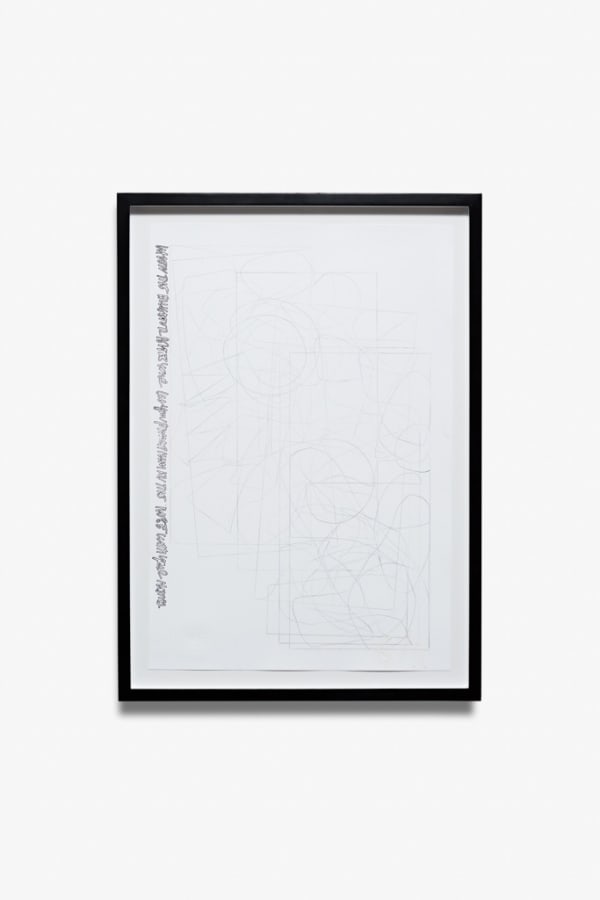Warmilk Blake Rayne
The exhibition’s title, Warmilk, is a play on the words war and milk, referring to the critical status of the political economy in order to feed the society. It can also be interpreted as warm and ilk (family, class, set of the same species or tissue), the nucleus of society, which would be family, the cozy and warm place everyone looks for orther issue that unites the parts, also leading us to the idea of screen or territory. Word play as technique to situate and desituate the viewer, is much associated with Marcel Duchamp, who permeates this exhibition in a certain way. In pieces on paper, the viewer is presented with a collection of paintings based on a drawing. Drawings are created with a rectangular stencil. The artist begins the drawing on one point and only ends it when the pencil returns to the same point; thus, he exempts himself from the question of whether the drawing or work is ready or not – which is aclassic artistic issue concerning modernity by the definition of the author. The many rectangles that appear successively create framings that, on the one hand, suggest Muybridge (the 19th century photographer who studied motion by successive photos of the same movement), and, on the other hand, the structure of the famous canvas Nude descending a staircase, from 1929, by Marcel Duchamp. We are on the edge between absolute self-control ofthe references and the compartment of a stencil; at the same time, the hand appears to be free to walk through any possible path. Through this basic structure, Blake Rayne performs his painting and ends it with a gesture of double meaning. He removed one of the fluorescent lamps from the gallery and crushed its glass, thus creating a glowing powder. By throwing this powder onto the drawings, the gesture leads us first to The Bride Stripped Bare by Her Bachelors, Even, 1915–1923, or the Large Glass (Duchamp), as it was called, both due to the rectangular shape ofthe pencil drawings, suggesting movement, and through the pretence of the broken glass. Secondly, the gesture also reminds us of the 3 stoppages étalon, 1913, (Duchamp), an experiment to imprison and obtain shapes by chance. The print running alongside the painting reads When the alligator bites your leg you punch him in the nose with your hand, an amusing pop insinuation to the self-help manuals that suggest simple solutions to complicated problems, and bring these paintings closer to the motivational poster.
Another piece in the exhibition is the video Untitled, in which the artist is seen with an iPhone filming the computer screen. The screen is divided. One side shows the Diary of a country Priest, and the other one shows Pickpocket, both films by Robert Bresson, from 1951 and 1959, respectively. In this performance, the artist struggles to spend aslong as possible holding his cell phone up, filming whatever goes on in front of him. Here, the line separating both films on screen is the division between idealism, in the case of Diary of a country Priest, and materialism, in the case of Pickpocket. This line separates two sides of the same coin, which is in constant crisis in the contemporary world, idealism and materialism; however, both have to live with one another.
The presence of the line in the exhibition indicates territories, something that, in its broader spectrum, is translated into the political division of the planet in nations. The sense of nationality is also the sense of exile; the feeling of looking for one’s own space. References to cinema, photography, posters and video raise awareness as to how we are defined, nowadays, by the things that surround us and are constantly changing: images. But we define ourselves by things we can record on cell phone or camera screens, generating more and new configurations of territories. This multiplication of borders may be the indication that, as political exiles, we can now be economical and social exiles; atlast, we might be exiles from ourselves. Here lies the poetry and the crisis of Blake Rayne. Good show!
Blake Rayne, born in Lewes in 1969, lives and works in New York. He was educated at the California Institute of the Arts, received a fellowship from the American Academy in Berlin (2010), and has taught at Columbia University’s School of Visual Arts. Solo exhibitions of Rayne’s work include Blake Rayne (1301PE, 2013), Wild Country (Campoli Presti, London, 2012), Blake Rayne (Formalist Sidewalk Poetery Club, Miami Beach, 2011), Shade Subscription (Capitain Petzel Gallery, Berlin, 2011), Coastal Graphics (Sutton Lane, Paris, 2011), and Folder and Application (Miguel Abreu Gallery, New York, 2010). He has also been featured in group exhibitions such as PLIAGE/FOLD (Gagosian Gallery, London, 2014) Chat Jet: Painting the Medium (Künstlerhaus, Graz, 2013), I Think and That Is All That I Am (Thomas Duncan Gallery, Los Angeles, 2012), System Analysis (Langen Foundation, Neuss, 2011) and New York to London and Back: The Medium of Contingency (Thomas Dane Gallery, London, 2011), as well as Bergen Kunsthall, The Kitchen, Sculpture Center, Artists Space, Green Naftali, and American Fine Arts.
– Ricardo Sardenberg











